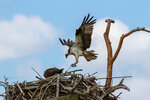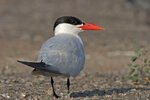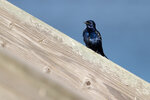



Earlier this week, a friend and I decided to look around for birds in downtown Olympia, and particularly around the Port (see map for specific locations mentioned). We were pleasantly surprised.
When I heard there is a heron rookery downtown, I was skeptical, but it’s true: It’s located in several good-sized pine trees along Capital Way in the first block south of the Olympia Farmers Market – in front of the old headquarters of the Washington Department of Wildlife. I could see at least three nests, and there were six, maybe more, Great Blue Heron fledglings waiting for their parents to return with food.
It’s quite a sight, to have an active heron rookery along an urban street, but there they are, and judging by the healthy fledglings we saw, they’re doing quite nicely. These young birds are funny looking, with a mohawk of feathers growing out from their crowns, and noisy, constantly squawking their “feed me” calls.
One of the challenges to success for a heron rookery is predation of the young. Bald Eagles are especially known to snatch them, eventually causing the herons to abandon a rookery site. Nesting in an urban area might provide some protection from predation. You probably have a week or so to check it out before the gangly young fly off for this nesting season.
The herons aren’t the only urban birds, and a walk on the Billy Frank Jr. Trail along East Bay revealed several more.
Near the tip of the port peninsula, KGY Radio has its very tall broadcasting tower. And it was that tower that next caught my eye, and ear. There are Purple Martin nesting boxes at several locations around the harbor, and apparently these martins have now fledged their young. We saw many young martins perched on the KGY tower, about 2/3rds of the way up, and adults flying in with food.
Purple Martins are members of the swallow family and make their living catching insects on the wing. The males are an unmistakable dark blueish-black; the females are much lighter gray with a light-gray chest and belly. They have a distinctive call, a loud, rich “cherr,” and right now it seems to be a constant sound around the Olympia harbor. Check it out on the Merlin app and you will recognize it when you hear it.
There’s another interesting nest in the outer port just south of KGY and the nearby restaurant. It’s an active Osprey nest, built on a platform attached to one of the port’s light poles. Ospreys are large hawk-sized fish-eating birds. (Their old-fashioned name was fish hawk.) They build nests near the tops of trees, usually near water. They also readily utilize whatever else might be available, including cell towers, or in this case a platform installed specifically for Osprey nesting.
Ospreys take up to 90 days to fledge their young, so these birds are likely to be at this location through the end of August. There is almost always one adult near the nest to protect the nest from predation. You might also see an Osprey searching for their prey, hovering over water getting ready to dive. They have a unique loud whistle call that alerts you to look up for an Osprey overhead.
The loudest birds at the port are Caspian Terns. At any time but high tide, a flock of 40 or more of these birds can be found on the mudflats off the north point of the port (again, near KGY). These birds might strike you as gulls, but they are distinct and readily identified by their large dark orangish-red bill and black crown. Their long, slender wings also make them more graceful in flight. They vocalize often with a loud harsh squawk. Again, the Merlin site will clue you in about what to listen for. Once you know this call, you might hear it almost anywhere, including over your house are they fly to feeding areas.
There is a huge breeding colony of Caspian Terns in Grays Harbor, and these Olympia birds, all adults in breeding plumage, might be the spillover of unsuccessful adults from that colony. Later in the summer, we will also be visited by juveniles chasing their parents seeking to be fed.
Caspian Terns (and Ospreys, for that matter) are some of the most widespread birds in the world. The terns gained their common name because they were, and are, common breeding birds in the Caspian Sea area of Eurasia. Both bird species generally migrate out of our area for the winter, although they are occasionally seen along the coast year-round.
George Walter is environmental program manager at the Nisqually Indian Tribe’s natural resources department; he also has a 40+ year interest in bird watching. He may be reached at george@theJOLTnews.com
Photos for this column are provided by Liam Hutcheson, a 16-year-old Olympia area birder and avid photographer.
1 comment on this item Please log in to comment by clicking here
Terrilovesanimals
Thank you SO much! This is wonderful. I have a friend back east that gets pictures of birds on his walks and I always wondered what was around here. I see my sparrows, some doves, Stellar's Jays and crows mostly. I really enjoyed this article!
Wednesday, July 19, 2023 Report this